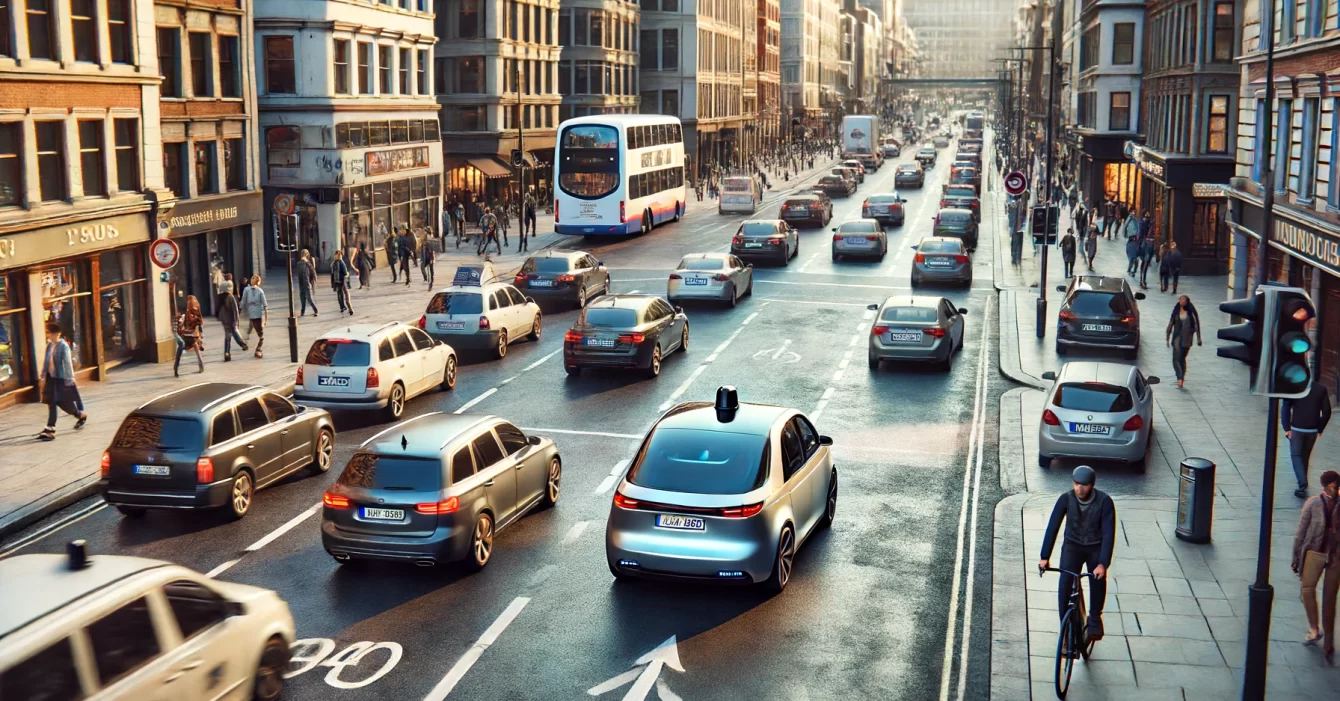Introduction:
A thought made by the World Economic Forum’s 2016 vision that “you’ll own nothing and you’ll be happy,”, comes to mind. They imagine a future where ownership is no longer a requirement to access essential services and consumer items. Instead, these goods and services can be centrally managed and optimized within a service-based economy. This shift raises an intriguing question: how many cars will we actually need if ownership becomes obsolete and self-driving technology prevails? By eliminating private car ownership and relying entirely on a fleet of shared self-driving electric vehicles, we could see a substantial decrease in the total number of vehicles required. This article explores the potential impact of this shift, based on a detailed analysis of commuting patterns, traffic data, and the efficiency of self-driving technology, while considering both the benefits and potential drawbacks.
Current Commuting Landscape:
In the UK, a significant portion of the population relies on private cars for their daily commute. Data from the Office for National Statistics (ONS) reveals that around 60% of employed individuals drive to work, leading to heavy traffic during peak hours. The traditional rush hours, spanning from 7-9 AM and 4-7 PM, see millions of cars on the road, causing congestion and longer travel times.
Impact of Self-Driving Cars:
Self-driving cars have the potential to transform this scenario by optimizing vehicle usage and reducing idle time. Unlike private cars, which are parked 95% of the time, self-driving cars can be utilized continuously, making multiple trips during peak periods. Our analysis assumes that each self-driving car can complete two trips per hour during rush hours, significantly increasing their efficiency compared to traditional vehicles.
Calculating the Reduction:
To estimate the reduction in the number of cars, we first consider the total number of people driving to work.
- Population and Employment Data:
- Total UK population: approximately 68 million.
- Employed Population: around 32.7 million (as of 2023) (Know Your Meme).
- Percentage driving to work: 60% (ONS data).
- Number of People Driving to Work:
- Employed drivers: 32.7 million× 60% = 19.62 million
- Required Traditional Cars During Peak Hours:
- Assuming each employed driver uses a car during peak periods: 19.62 million.
- Required Self-Driving Cars:
- Each self-driving car can serve eight trips in a four-hour period.
- Required self-driving cars: 19.62 million / 8 = 2.45 million
- Adjustment for Regional Variations and School Commutes:
- Applying the regional adjustment factor: 2.45 million × 1.2 = 2.94 million2.45.
The Numbers:
- Traditional Cars Needed: 19.62 million
- Self-Driving Cars Needed: 2.94 million
- Reduction Factor: (19.62 − 2.94) / 19.62 = 85%
This reduction means that with a fully self-driving fleet, the UK could potentially reduce the number of cars on the road by about 85%.
Benefits Beyond Reduction:
The benefits of this reduction extend beyond just fewer cars on the road. These include:
- Reduced Charging Station Infrastructure: Fewer cars mean fewer charging stations are needed, simplifying infrastructure requirements.
- Reduced Congestion: With fewer cars on the road, traffic congestion will decrease, leading to shorter travel times and less stress for commuters.
- Reduced Material Use: The production of fewer cars translates to less use of materials, contributing to a more sustainable economy.
- Increased Efficiency: Optimized use of self-driving cars ensures that vehicles are utilized more effectively, reducing the need for excess capacity.
Potential Drawbacks:
However, this shift is not without its challenges and potential drawbacks:
- Loss of Ownership: Many individuals value the sense of ownership and control that comes with owning a private vehicle. This change could lead to a sense of loss and decreased personal satisfaction for some people.
- Privacy Concerns: The central management of shared self-driving cars could raise privacy issues, as detailed trip data might be collected and monitored.
- Initial Transition Costs: The initial investment required to develop, deploy, and maintain a fleet of self-driving cars could be substantial.
- Technological and Regulatory Hurdles: Ensuring the safety, reliability, and regulatory compliance of self-driving cars poses significant technological and legal challenges.
Conclusion:
The transition to a fully self-driving, shared vehicle system holds the promise of a transformative impact on urban mobility in the UK. By drastically reducing the number of cars needed on the road, we can create more efficient, sustainable, and livable cities. However, careful planning and collaboration between policymakers, technologists, and the public will be essential to navigate the challenges and maximize the benefits of this revolutionary change.
References:
- RAC Media Centre. “Morning rush hour traffic returns.” September 21, 2020.
- Fleet News. “Roads data suggests rush hour return.” September 21, 2020.
- Bolt Blog. “The impact of restricting private cars during rush hour.” April 24, 2023.
- Office for National Statistics (ONS). Employment and commuting data.
- https://terajouleenergy.com/the-future-of-transport-a-journey-towards-innovation-and-efficiency/
- World Economic Forum. “8 predictions for the world in 2030.” 2016.




